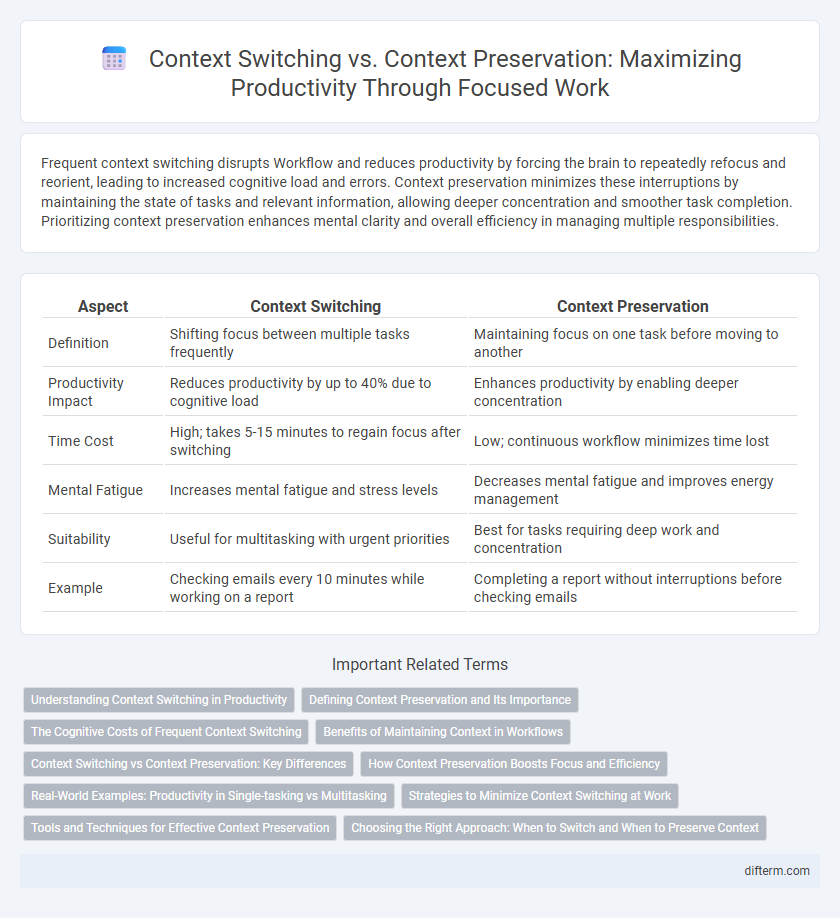Frequent context switching disrupts Workflow and reduces productivity by forcing the brain to repeatedly refocus and reorient, leading to increased cognitive load and errors. Context preservation minimizes these interruptions by maintaining the state of tasks and relevant information, allowing deeper concentration and smoother task completion. Prioritizing context preservation enhances mental clarity and overall efficiency in managing multiple responsibilities.
Table of Comparison
| Aspect | Context Switching | Context Preservation |
|---|---|---|
| Definition | Shifting focus between multiple tasks frequently | Maintaining focus on one task before moving to another |
| Productivity Impact | Reduces productivity by up to 40% due to cognitive load | Enhances productivity by enabling deeper concentration |
| Time Cost | High; takes 5-15 minutes to regain focus after switching | Low; continuous workflow minimizes time lost |
| Mental Fatigue | Increases mental fatigue and stress levels | Decreases mental fatigue and improves energy management |
| Suitability | Useful for multitasking with urgent priorities | Best for tasks requiring deep work and concentration |
| Example | Checking emails every 10 minutes while working on a report | Completing a report without interruptions before checking emails |
Understanding Context Switching in Productivity
Context switching occurs when a person shifts their attention from one task to another, causing cognitive disruption and reduced efficiency. Research shows that frequent context switching can decrease productivity by up to 40%, as the brain needs time to realign focus and recall relevant information. Preserving context through task batching or minimizing interruptions supports sustained concentration and enhances overall work performance.
Defining Context Preservation and Its Importance
Context preservation involves maintaining focus on a single task or project without interruption, thereby reducing cognitive load and enhancing efficiency. This approach minimizes the mental effort required to reorient attention, leading to higher productivity and improved work quality. Emphasizing context preservation is crucial for sustaining deep work states and achieving consistent progress in complex tasks.
The Cognitive Costs of Frequent Context Switching
Frequent context switching significantly increases cognitive load by forcing the brain to repeatedly disengage from one task and re-engage with another, leading to reduced focus and efficiency. Studies show it can result in an average productivity loss of up to 40%, as working memory and attention resources are continuously depleted. Preserving context through task batching or minimizing interruptions enhances mental clarity and sustains deep work performance.
Benefits of Maintaining Context in Workflows
Maintaining context in workflows reduces cognitive load by minimizing the need to reorient tasks, leading to improved focus and higher efficiency. Preserving context enables smoother transitions and ensures continuity, which results in fewer errors and faster completion times. Consistent context retention also supports better memory recall and decision-making, significantly enhancing overall productivity.
Context Switching vs Context Preservation: Key Differences
Context switching involves frequent shifts between tasks that cause cognitive load and reduce overall productivity, while context preservation maintains focus by minimizing interruptions and allowing deeper engagement with a single task. Key differences include the impact on mental clarity, where context switching fragments attention and impairs memory recall, whereas context preservation enhances concentration and task completion efficiency. Organizations emphasizing context preservation benefit from increased output quality and reduced burnout compared to those tolerating frequent context switching.
How Context Preservation Boosts Focus and Efficiency
Context preservation minimizes cognitive load by maintaining task-related information, reducing the time and mental effort needed to reorient between activities. This continuity enhances focus by allowing deeper engagement with current work, leading to faster problem-solving and higher-quality output. Consistent context retention supports efficient use of cognitive resources, ultimately driving sustained productivity improvements.
Real-World Examples: Productivity in Single-tasking vs Multitasking
Single-tasking enhances productivity by minimizing cognitive load, as evidenced by software developers who complete complex coding tasks faster when focusing solely on one project. In contrast, multitasking often leads to significant time loss due to context switching, demonstrated by customer service agents who handle multiple chats simultaneously but experience increased errors and slower response times. Real-world studies reveal that preserving context through dedicated work blocks results in higher quality output and greater efficiency compared to frequent task switching.
Strategies to Minimize Context Switching at Work
Minimizing context switching at work involves strategies like time blocking, where specific periods are dedicated to single tasks to enhance focus and reduce cognitive load. Implementing task batching allows grouping related activities, which preserves mental context and reduces the disruption caused by switching. Using tools such as digital to-do lists and minimizing notifications further supports sustained attention and boosts overall productivity.
Tools and Techniques for Effective Context Preservation
Effective context preservation relies on tools such as digital note-taking apps like Notion and Evernote, which enable seamless capture and organization of information. Techniques including time-blocking and task batching minimize cognitive load by maintaining focus within a single context. Leveraging automation tools like Zapier can further enhance context preservation by integrating workflows and reducing manual context shifts.
Choosing the Right Approach: When to Switch and When to Preserve Context
Effective productivity hinges on discerning when to switch tasks versus preserving context; frequent context switching can lead to cognitive overload and reduced efficiency, while context preservation supports deep focus and momentum. High-priority or urgent tasks often necessitate a deliberate switch, whereas complex projects benefit from sustained attention to maintain continuity and prevent information loss. Balancing these approaches depends on task complexity, urgency, and individual cognitive capacity to optimize overall workflow and output quality.
Context Switching vs Context Preservation Infographic

 difterm.com
difterm.com